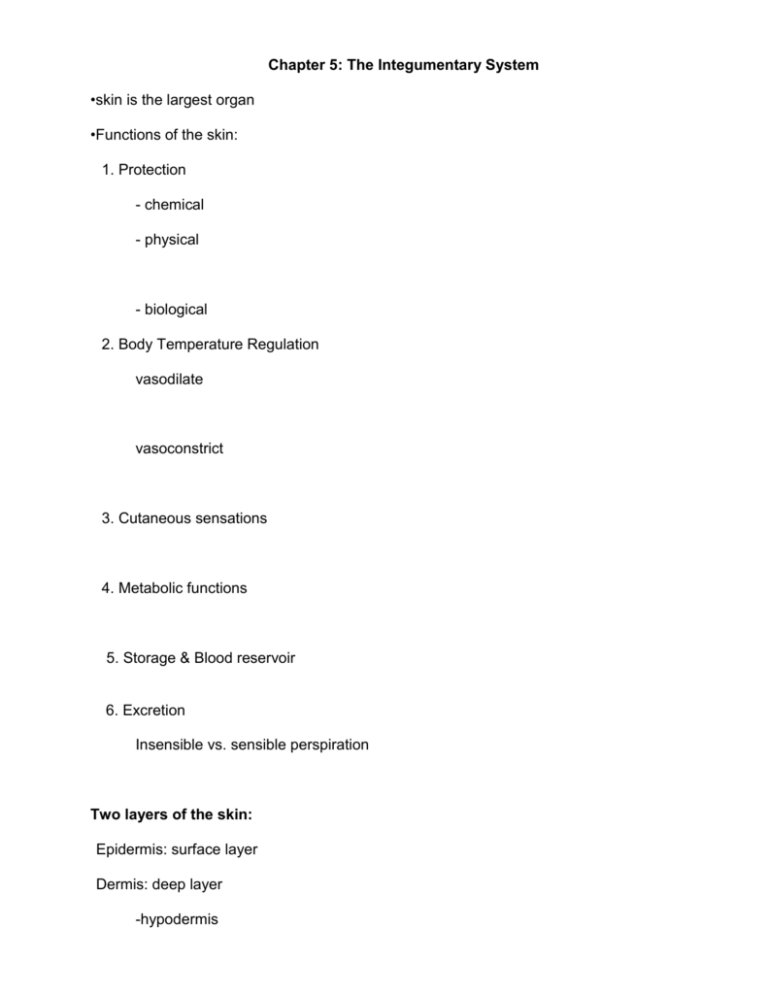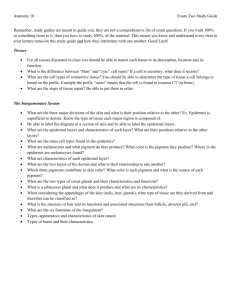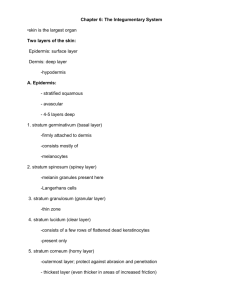Chapter 5 notes
advertisement

Chapter 5: The Integumentary System •skin is the largest organ •Functions of the skin: 1. Protection - chemical - physical - biological 2. Body Temperature Regulation vasodilate vasoconstrict 3. Cutaneous sensations 4. Metabolic functions 5. Storage & Blood reservoir 6. Excretion Insensible vs. sensible perspiration Two layers of the skin: Epidermis: surface layer Dermis: deep layer -hypodermis A. Epidermis: - stratified squamous - avascular - 4-5 layers deep Cells of epidermis 1. Keratinocytes: produce -keratin -connected by desmosomes -begin 2. Melanocytes: pigment melanin - spider shaped - found in -melanin is formed in the cell & moved out towards processes -melanin accumulates on the top of the nucleus -all people have the same # of cells but differ in skin color due to difference in melanocyte activity. 3. Langerhans cells -formed in bone marrow & -are star shaped macrophages 4. Merkel cells -present in small numbers at the epidermis/dermis junction -associated w/ a disc like ending of a sensory nerve -merkel disc = merkel cell + dendrite Layers of the epidermis: thicker skin has 5 layers (strata) 1. stratum germinativum (basal layer) -deepest epidermal layer -firmly attached to dermis -consists mostly of 2. stratum spinosum (spiney layer) -several layers thick -melanin granules present here -Langerhans cells 3. stratum granulosum (granular layer) -thin zone -keratin and keratohyalin 4. stratum lucidum (clear layer) -consists of a few rows of flattened dead keratinocytes -present only 5. stratum corneum (horny layer) -outermost layer; protect against abrasion and penetration - cell layers thick -held tightly together by desmosomes Carotene, Melanin and Dermal Circulation Epidermis and Steroid Production Vitamin D3 (cholecalciferol) Epidermal Growth Factor (EGF) B. Dermis •cells found here are those typically found in connect. tissue •gel-like matrix heavily embedded w/ collagen, elastin, & reticular fibers •dermis is your "hide" •richly supplied with •Two layers 1. papillary layer: lots of blood vessels -contain dermal papillae, Meissner's corpuscles -epidermal ridges on ventral surface of hands & feet along with dermal papillae arranged in patterns create 2. reticular layer -80% of the thickness of dermis -contains bundles of collagen fibers -cleavage or tension lines in the skin -stretch marks -blister: Subcutaneous Layer (hypodermis) Hair: •only hairless skin: •primary function: •3 layers: medulla, cortex, cuticle 1. medulla: 2. cortex: 3. cuticle: outermost •hair grows as result of mitotic activity of epidermal cells at the bottom of the hair follicle -hair growth is cyclic -follicles extend from dermis --> epidermis -portion of dermis protrudes into bottom of follicle forming a papilla which contains •root: •shaft: •each follicle has a Sebaceous gland hair color determined by melanin arrector pili: smooth muscle Vellus hair vs. Terminal hair Nails: -thick, heavy keratinized cells -Three regions -lunula: Sebaceous (Oil) glands Sebum Sebaceous follicles Sweat (Sudoriferous) Glands: - distributed all over the skin Merocrine (Eccrine) Apocrine Ceruminous Injury Response (figure 5-13) Aging and the Integument pg 173 Skin cancers, Melanomas, Sunblocks pg 160 Burns and Grafts pg 172











